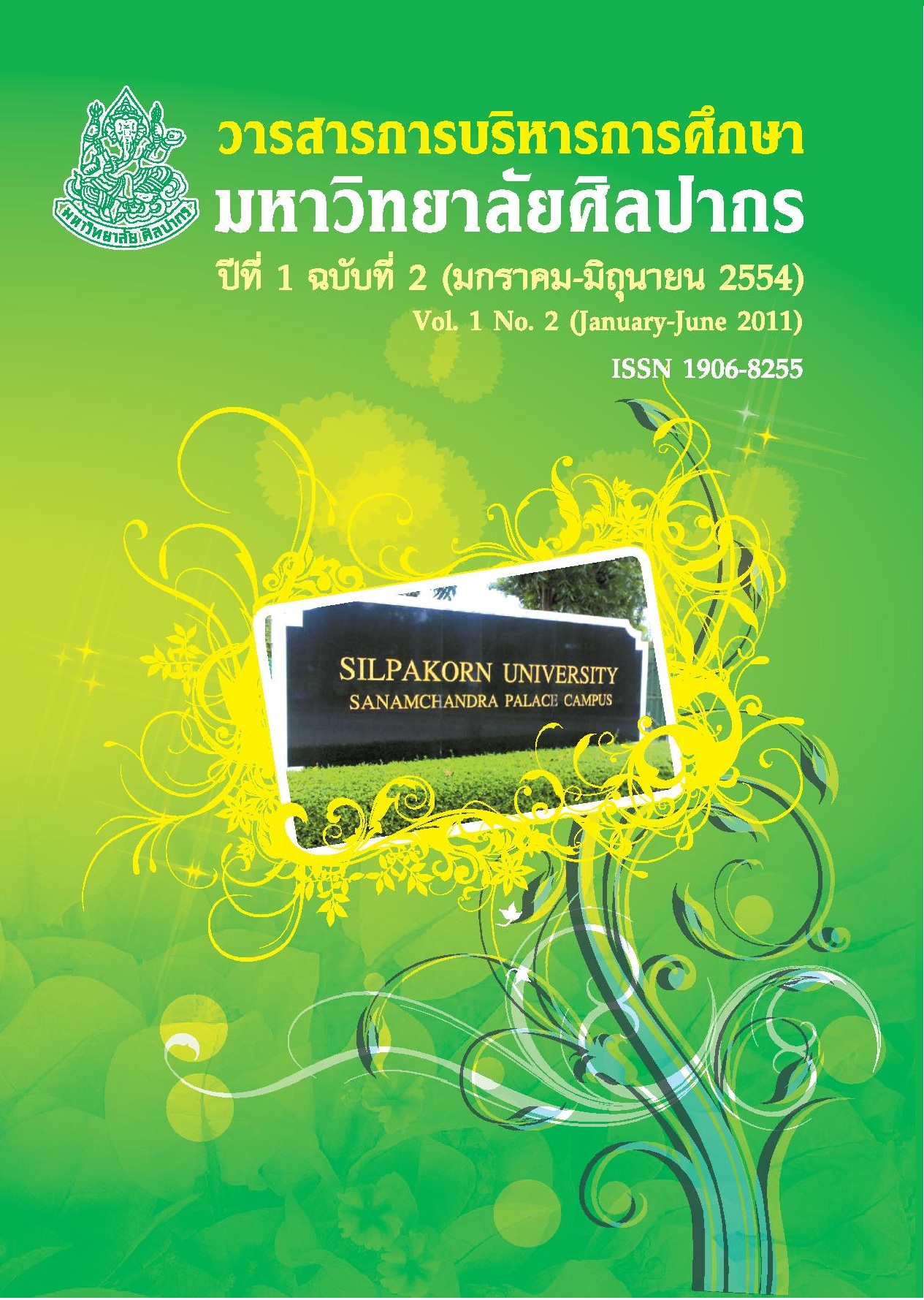การบริหารงานบริการการได้ยินของโรงเรียนโสตศึกษาต้นแบบทดลองสองภาษาในประเทศไทย
คำสำคัญ:
การบริหารงานบริการการได้ยิน, โรงเรียนสองภาษา, โสตศึกษา, Hearing services administration, Bilingual School, The deafบทคัดย่อ
งานวิจัยนี้มีวัตถุประสงค์เพื่อทราบ 1) องค์ประกอบของการบริหารงานบริการการได้ยินของโรงเรียนโสตศึกษาต้นแบบการทดลองสอนสองภาษา และ 2) รูปแบบการบริหารงานบริการการได้ยินของโรงเรียนโสตศึกษาต้นแบบโดยการทดลองสอนสองภาษาที่เหมาะสมสำหรับอนาคต กลุ่มตัวอย่างที่ใช้ในการวิจัยครั้งนี้ แบ่งออกเป็น 2 กลุ่ม กลุ่มที่หนึ่ง ได้แก่ โรงเรียนโสตศึกษาต้นแบบ 4 แห่ง โดยวิธีการเจาะจง ผู้ให้ข้อมูลประกอบด้วยผู้บริหารสถานศึกษา ครู บุคลากรทางการศึกษา และอื่นๆ โรงเรียนละ 6-8 คน ใช้การสัมภาษณ์ และประชุมสนทนากลุ่ม (focus group discussion) กลุ่มที่สอง เป็นโรงเรียนโสตศึกษาอื่นๆ อีก 16 แห่ง โดยการสุ่มอย่างง่าย เครื่องมือที่ใช้เป็นแบบสอบถาม ผู้ให้ข้อมูลได้แก่ ผู้บริหารสถานศึกษา ครู บุคลากรทางการศึกษา และอื่นๆ โรงเรียนละ 20 คน รวมทั้งสิ้น 320 คน สถิติที่ใช้ในครั้งนี้ คือ ค่าความถี่ (frequency) ร้อยละ (percentage) การวิเคราะห์องค์ประกอบ (factor analysis) การวิเคราะห์เชิงสาเหตุ (path analysis) และการวิเคราะห์เนื้อหา (content analysis)
ผลการวิจัยพบว่า
1. องค์ประกอบของการบริหารงานบริการการได้ยินของโรงเรียนโสตศึกษาต้นแบบการทดลองสอนสองภาษา มี 4 องค์ประกอบ ได้แก่ การบริหารจัดการที่ดี การดำเนินงานสอดคล้องกับวิถีชีวิตคนพิการ การบริการสนับสนุน และการจัดการศึกษา โดยมีตัวแปรองค์ประกอบจำนวน 23, 17, 15 และ 3 ตัวแปรตามลำดับ และสามารถอธิบายความแปรปรวนขององค์ประกอบได้ร้อยละ 67.36 พร้อมทั้งโมเดลมีความสอดคล้องกับข้อมูลเชิงประจักษ์ในระดับดีมาก
2. รูปแบบการบริหารงานบริการการได้ยินของโรงเรียนโสตศึกษาต้นแบบโดยการทดลองสอนสองภาษาที่เหมาะสมสำหรับอนาคต พบว่า รูปแบบที่นำเสนอทั้ง 4 องค์ประกอบ มีค่าสหสัมพันธ์พหุคูณกำลังสอง เท่ากับ .808, .570 และ .446 ตามลำดับ โดยที่ (1) การบริหารจัดการที่ดีมีอิทธิพลทางตรงต่อการดำเนินการที่สอดคล้องกับคนพิการ และการบริหารสนับสนุน ส่วนทางอ้อมได้แก่การจัดการศึกษา (2) การบริการสนับสนุนมีอิทธิพลทางตรงต่อการจัดการศึกษา และทางอ้อมได้แก่การดำเนินการที่สอดคล้องกับคนพิการ และ (3) การจัดการศึกษามีอิทธิพลทางตรงต่อการดำเนินการที่สอดคล้องกับคนพิการ อย่างมีนัยสำคัญทางสถิติที่ระดับ .01 ตามลำดับ ทั้งนี้ ผู้เชี่ยวชาญมีความเห็นว่ารูปแบบมีความเหมาะสม มีความเป็นไปได้ มีความถูกต้อง และสามารถนำไปใช้ประโยชน์ในการพัฒนาโรงเรียนโสตศึกษาทั่วประเทศได้เป็นอย่างดี พร้อมทั้งเสนอให้ผู้ปกครอง และการแพทย์เข้ามามีส่วนร่วมมากขึ้น
HEARING SERVICES ADMINISTRATION IN BILINGUAL SCHOOLS FOR THE DEAF
The purposes of this research were 1) to identify the factors of the hearing services administration of bilingual schoolfor thedeaf, and 2) to confirm the model of the hearing services administration of bilingual schools for the deaf for the future. The samples were divided into twogroups : firstly, the purposive sampling four schools for the deaf,the 6-8 respondents were administrators, teachers,educational personnels and others responding interview and focus group discussion. The second groups were 16 other schools selected by simple random sampling. The questionnaier was an instrument for collecting the data from 320 respondents whish compoesd of administrators, teachers, educational personnels and others totally 20 persons of each school. The statistical analysis was frequency, percentage, factor analysis, path analysis and content analysis.
The findings of the study were as follows :
1. The factors of the hearing services administration of bilingual school for the deaf had four factors : good managerial administration, performance according to the disabilities' path, service support and educationmanagement; having the factorial components 23, 17, 15, and 3 variables respectively, and explainable the factors variance at 67.36 percents; additionally, this model was fitted to the objective data in the highest level.
2. The model of the hearing services administration of bilingual schools for the deaf for the future was revealed that the fourcomponents proposed model had the square multiple correlation equally to .808, .570 and .446 respectively, following; (1) goog managerial administration had a dircet effect to performance according to the disabilities' path, and service support had an indirect effect to the educational management, (2) theservice support had adirect effect to the educational management, and indirect effect to performance according to the disabilities' path, and (3) the educational management had a direct effect to performance according to the disabilities' path, respectively significant at the level of .01. Hence, the experts approved the model, was suitability, feasibility, accuracy, and advantages in developing the bilingual schools for the deaf throughout the country, moreover, the parents and medical services factors were well accepted for more participation in the future.




